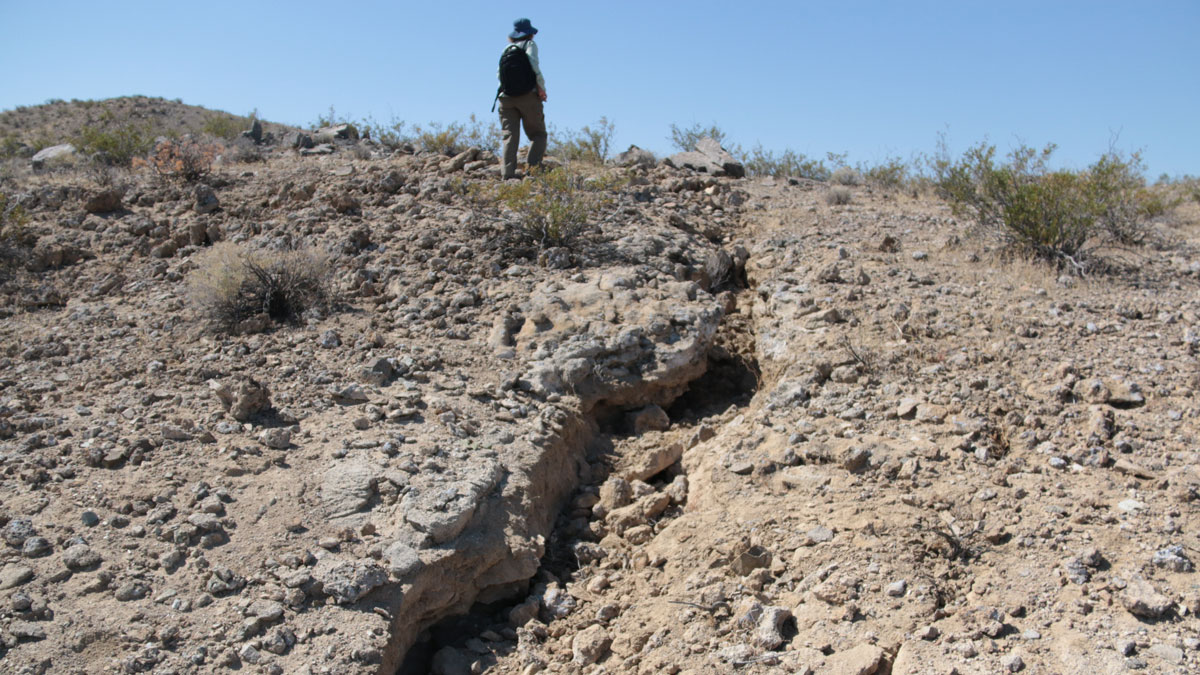As tectonic stress is released during an earthquake, rock slips, and Earth’s crust is damaged, like a wound to the skin. And like skin, the scar-like wounds left after an earthquake can heal, and the impacted area can recover its strength over time. A study published in Science indicates that such recovery may be limited to only the upper crustal layers. The deep crust takes much longer to recover—or possibly doesn’t recover at all.
Lasting Change to the Deeper Crust
The findings stemmed from what was meant to be only a test of a new technique.
Jared Bryan, a geophysicist at the Massachusetts Institute of Technology (MIT) and first author of the new study, was refining a method to investigate localized damage to Earth’s crust by measuring the speed at which seismic waves generated by distant earthquakes pass through it.
Bryan wanted to use the technique to study volcanoes, but as a test, he turned to California’s 2019 Ridgecrest earthquake sequence—a magnitude 6.4 foreshock followed by a magnitude 7.1 main shock. “What brought me originally to working on the Ridgecrest fault zone was just that I wanted an obvious signal that I could use to calibrate my technique,” Bryan said. Conveniently, the region had readily available seismic wave data from 34 permanent seismic stations within 74 miles (120 kilometers) of the fault zone.
Between 2015 and 2023, 5,500 earthquakes generated seismic signals that traveled through Earth’s crust and arrived vertically at the seismic stations, allowing the team to track the seismic wave velocities before and after the Ridgecrest earthquake. Earthquake damage creates fractures in the rock, measurably slowing seismic waves passing through it. After the test, Bryan planned to use the technique to study volcanoes. But the results were too intriguing to abandon.
Previous studies of earthquake damage were limited to the shallow crust, typically less than 6 miles (10 kilometers) down, or averaged the results across all depths.
“You could never tell where those changes really were a function of depth, and that’s crucial,” said geophysicist Roland Bürgmann from the University of California, Berkeley, who wasn’t involved in the study.
The technique researchers used in the new study, however, detects changes equally well throughout the entire crustal column, from the surface down to 15 miles (25 kilometers). “What we were most excited about was using this method that allows us to image how things change in the Earth beyond the depth that we typically think about doing that sort of work,” said William Frank, a geophysicist at MIT and coauthor of the study.
Tracking the seismic waves passing through the crust around the Ridgecrest earthquake, the researchers saw that in the upper crust, waves slowed, then returned to normal within months, indicating the crust had, indeed, been damaged but had recovered.
The finding that the lower crust experiences slow, evolving, and enduring damage is “completely new and novel.”
However, seismic waveform data from deeper down, between 6 and 9 miles (10 and 15 kilometers), indicated that the damage accumulated more slowly and did not heal over the 3-year-plus time span analyzed after the quake. Bryan said that data showing changes to waveforms are usually subtle, requiring careful quantification, but that was not the case with data from the deeper crust. “I could see, visually, this permanent change at the time of the earthquake,” he said.
Bürgmann said that the finding that the lower crust experiences slow, evolving, and enduring damage is “completely new and novel.”
Looking Beyond Ridgecrest
The scientists suggest two possible outcomes for damage to the deep crust. Either the damaged area will recover, albeit over decades or centuries rather than months, or the changes will be permanent, and the fault zone’s structure will progressively shift with each earthquake.
Since the Ridgecrest region has not experienced as many earthquakes as more mature fault zones, it’s possible “we’re watching these fault zones mature in real time,” Bryan said.
The team wants to apply the same method to more mature faults like the well-studied San Andreas zone to the west. If data indicate the deeper crust of a mature fault zone heals after an earthquake, the lasting damage at Ridgecrest could be a characteristic of fault evolution.
Research on recovery in the deep crust is “going to place important constraints on how we model that evolution and how that then impacts our future forecasts of where and how earthquakes might happen,” Frank said.
—Andrew Chapman (@andrewchapman.bsky.social), Science Writer

